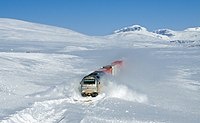
Photo from wikipedia
Snow depth (SD) is an indispensable parameter for many studies. Launched in 2018, the Ice, Cloud and land Elevation Satellite-2 (ICESat-2) is designed to obtain global glacial elevations, but it… Click to show full abstract
Snow depth (SD) is an indispensable parameter for many studies. Launched in 2018, the Ice, Cloud and land Elevation Satellite-2 (ICESat-2) is designed to obtain global glacial elevations, but it can also acquire canopy and terrain elevations. Whether the depth of seasonal snow can be estimated by directly comparing the difference in elevations in snow-cover and snow-free cases, many people may reasonably ask. In this letter, we conduct such an investigation in Altay, Northwest China, using ICESat-2 ATL08 elevation products. Our investigation suggests: 1) in mountainous areas, the answer maybe is no because the estimation is obviously affected by rugged topography; 2) but in flat regions, SDs have been effectively estimated. (The $R^{2}$ is up to 0.88 between estimates and ground measurements.); and 3) as expected, land-cover types also affect the accuracy of the results, and the best estimation happens over the type of bare land. Therefore, estimating the depth of seasonal snow from the ICESat-2 product may be feasible, but we must check the results carefully.
Journal Title: IEEE Geoscience and Remote Sensing Letters
Year Published: 2022
Link to full text (if available)
Share on Social Media: Sign Up to like & get
recommendations!